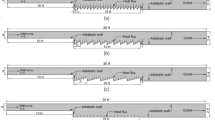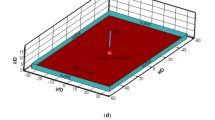Summary
This study presents the numerical predictions of the fluid flow and heat transfer characteristics for a backward-facing step by discharging a jet perpendicularly to the main flow. The turbulent governing equations are solved by a control-volume-based finite-difference method with power-law scheme and the well known K−ε model and its associate wall function to describe the turbulent behavior. The interesting parameters include entrance Reynolds number (Re h ), dimensionless jet location (X j/H) and the ratio of jet velocity (U j/U0) with channel expansion ratio ER=1.67. The predicted attachment point is in good agreement with the experiment. It is found that the optimum position is atX j/H=2.1 (X j: location of jet measured from the step position, H: the step height).
Similar content being viewed by others
Abbreviations
- B:
-
nozzle width
- C 1,C 2,C μ :
-
turbulent constant
- D:
-
channel height
- ER:
-
expansion ratio,\(\frac{{D + H}}{D}\)
- G:
-
generation rate of turbulent kinetic energy
- H:
-
step height
- h x :
-
local heat transfer coefficient
- J:
-
velocity ratio,U j/U 0
- K:
-
turbulent kinetic energy
- q″:
-
heat flux
- Re h :
-
Reynolds number based on step height,U 0 H/ν
- S ϕ :
-
source term
- T:
-
temperature
- U 0 :
-
inlet velocity
- U j :
-
jet velocity
- Uτ :
-
friction velocity
- U, V:
-
x, y component velocity
- X j :
-
position of discharging jet
- X R :
-
reattachment length of the main flow
- X jR :
-
reattachment length of the upper discharging jet flow
- y + :
-
dimensionless distance from the wall
- ϕ:
-
dependent variables
- Γφ :
-
turbulent diffusion coefficient
- μ e , μ l , μ T :
-
effective, laminar, turbulent viscosity
- ϱ:
-
density
- ϰ:
-
Von Kármán constant
- σ:
-
turbulent Prandtl number
- τ w :
-
wall shear stress
- ε:
-
turbulent energy dissipation rate
References
Abbot, D. E., Kline, S. J.: Experimental investigation of subsonic turbulent flow over single and double backward facing step. J. Basic Eng. Trans. ASME84, 317 (1962).
Seban, R. A.: Heat transfer to the turbulent separated flow of air downstream of a step in the surface of plate. J. Heat Transfer. Trans. ASME86, 259–262 (1964).
Aung, W., Goldstein, R. J.: Heat transfer in turbulent separated flow downstream of a rearward-facing step. Isr. J. Tech.10, 35–41 (1972).
Eaton, J., Johnston, J. P.: A review of research on subsonic turbulent flow reattachment. AIAA J.19, 1093–1100 (1981).
Armaly, B. F., Durst, F., Kottke, V.: Momentum heat and mass transfer in backward-facing step flow. Proceedings of 3rd Symposium on Turbulent Shear Flows, Davis, CA, 16.1–16.4 (1981).
Armaly, B. F., Durst, F., Pereira, J. C. F., Schonung, B.: Experimental and theoretical investigation of backward facing step flow. J. Fluid Mech.127, 473–496 (1983).
Simpson, R. L.: A model for the backward mean velocity profile. AIAA J.21, 142–143 (1983).
Vogel, J. C., Eaton, J. K.: Combined heat transfer and fluid dynamic measurements downstream of a backward-facing step. J. Heat Transfer107, 922–929 (1985).
Sparrow, E. M., Kang, S. S., Chuck, W.: Relation between the points of flow reattachment and maximum heat transfer for regions of flow separation. Int. J. Heat Mass Transfer30, 1237–1246 (1987).
Sparrow, E. M., Chuck, W.: PC solutions for heat transfer and fluid flow downstream of an abrupt, asymmetric enlargement in a channel. Numer. Heat Transfer12, 19–40 (1987).
Vradis, G., Nostrand, L. Van: Laminar flow and heat transfer downstream of a confined backward facing step including variable viscosity effects. Simul. Numer. Methods Heat Transfer, ASME, HTD,157, 1–8 (1990).
Hong, B., Armaly, B. F., Chen, T. S.: Mixed convection in a duct with a backward-facing step uniform heat flux case. Fundamentals of Mixed Convection, ASME HTD-213, 73–78 (1992).
Oyakawa, K., Koike, T., Mabuchi, I.: Studies of heat transfer control by using jet discharge at reattachment region downstream of a backward-facing step. JSME59, 543–549 (1993).
Jayatilleke, C. L. V.: The influence of Prandtl number and surface roughness on the resistance of the laminar sublayer to momentum and heat transfer. Prog. Heat Mass Transfer1, 193–329 (1969).
Patankar, S. V.: Numerical heat transfer and fluid flow. New York: Mc Graw-Hill 1980.
Author information
Authors and Affiliations
Rights and permissions
About this article
Cite this article
Yang, Y.T., Huang, M.L. Numerical studies of heat transfer characteristics by using jet discharge at downstream of a backward-facing step. Acta Mechanica 128, 29–37 (1998). https://doi.org/10.1007/BF01463157
Received:
Revised:
Issue Date:
DOI: https://doi.org/10.1007/BF01463157




